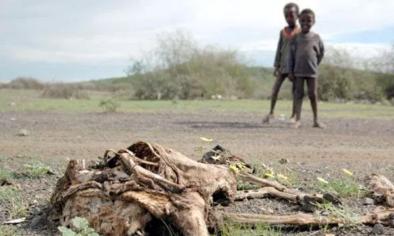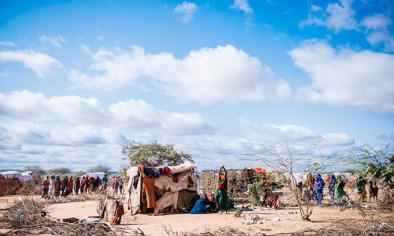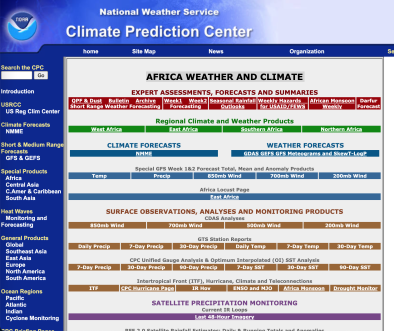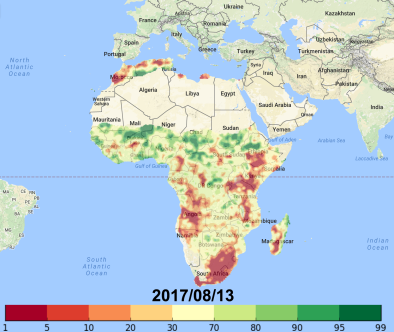Horn of Africa Drought 2015 -
The worst Horn of Africa drought in decades continues to plague large portions of Ethiopia, Kenya and Somalia as well as nearby countries, due to widespread drought worsened by El Niño and climate change.[1]
Climate change contributed to the intensity of the 2015-2016 El Niño — which brings drier conditions to much of Ethiopia and northern Uganda[4][5] — in the form of very warm sea surface temperatures.[6] A 2015 study found that 20th century drying of the eastern Horn of Africa (Somalia, Djibouti, and eastern Ethiopia) is unusual based on the record and that it occurred at the same time as recent global and regional warming, suggesting it may be partly attributable to anthropogenic global warming.[2] Furthermore, multiple studies have found that rainfall during the more critical "long rains" has declined over the last few decades in some of the region's countries,[2][3] and one study linked these precipitation changes to increases in regional sea surface temperature (SST).[2]
Human-caused warming reduced rainfall in Northeast Africa by approximately 16 percent, contributing to substantial food crises.[6]

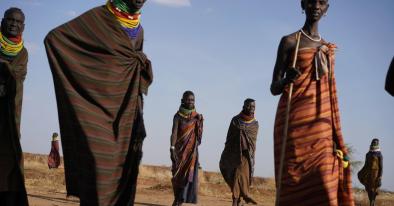

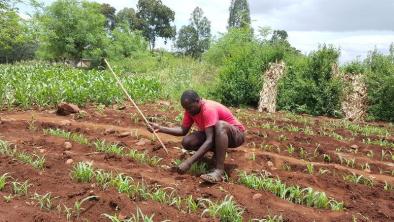
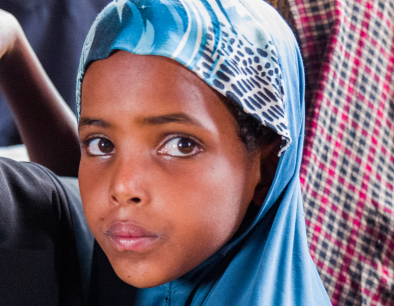
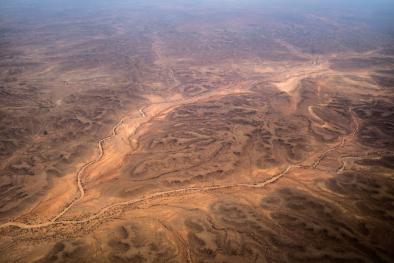
Climate science at a glance
- Long rains (from March until June) have declined in Somalia, Djibouti, and eastern Ethiopia over the last three decades.[1]
- In general, La Niña and/or negative Indian Ocean Dipole (IOD) events, both of which occurred in the fall of 2016, bring drier conditions to East Africa, whereas El Niño and/or positive IOD events bring wetter conditions.[2][3]
- However, El Niño typically brings drier conditions to much of Ethiopia,[4] as well as to northern Uganda.[5]
- Human-caused warming contributed substantially to very warm 2015/16 El Niño sea surface temperatures.[6]
- Warming due to human activities likely reduced rainfall in Northeast Africa by approximately 16 percent, contributing to substantial food crises.[6]
- El Niño events of the past few decades have been more variable and more intense than the norm established over the past 7,000 years.[7]
- An analysis of northwest and southeast Kenya by the World Weather Attribution (WWA) partnership found current SST patterns, such as La Niña, to be the dominant influence on the ongoing drought.[8] While the analysis did not find a trend in rainfall, the drought was determined to be hotter than it would have been in the absence of climate change.[8]
- The autumn rains, however, brought only about 50 percent of normal second-half-of-the-year rainfall,[9] leading to crop failures and severe food shortages.[2] In most of Somalia this was a 1-in-10 to 30 year event; in Somaliland, a 1-in-100 year event.[9] The strong La Niña that was active at the time was responsible for about one-third of the precipitation deficit.[9] It also amplified the probability of a dry season.[9]
- The direct fingerprint of climate change in Somalia's portion of the Horn of Africa drought could not be identified due to the overwhelming signal of natural variability (that is, the influence of climate change was drowned out by "louder" processes).[9]
Climate change intensifies Horn of Africa drought- and heat-caused food crisis
Over the last few years, several countries in the Horn of Africa have dealt with on-and-off droughts that have been exacerbated by El Niño (or La Niña, depending on the location) and climate change. Ethiopia, Kenya, and Somalia have been the hardest-hit.
Declines in the 'long' rainy season linked to global warming
There are two rainy seasons in most of East Africa.[2] The "long rains," which are connected to the development of the Indian monsoon, run from March until June.[2] The "short rains" run from October to November.[2] While both rains are important, the long rains are more critical[2] — and according to a 2015 study from the journal Science Advances, their rainfall has declined in the eastern Horn of Africa (Somalia, Djibouti, and eastern Ethiopia) over the last three decades.[1]
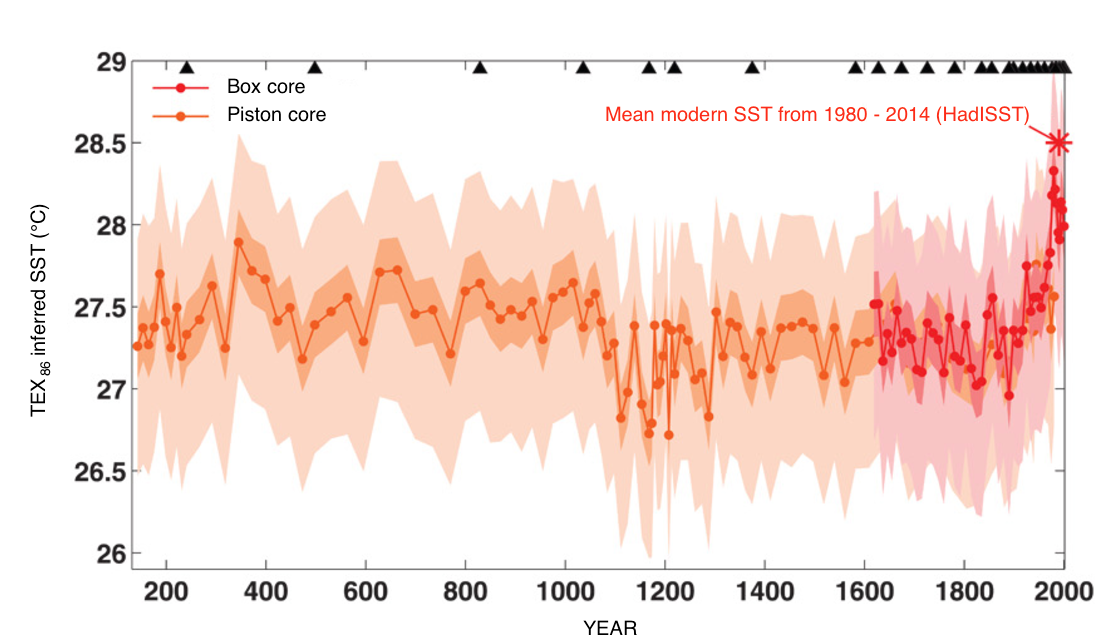 The authors of the study reconstructed past changes in sea surface temperature (SST) and aridity over the last 2000 years using sediment cores from the Gulf of Aden.[1] They found that before the 20th century, (150-1850 AD) regional SSTs varied within 1.5°C. Between the late 1800s and 2001, regional SSTs increased by about 0.8°C, in agreement with observational estimates.[1] They also found that 20th century drying of the region is unusual based on the record and that it occurred at the same time as recent global and regional warming — suggesting it may be partly attributable to anthropogenic global warming.[1]
The authors of the study reconstructed past changes in sea surface temperature (SST) and aridity over the last 2000 years using sediment cores from the Gulf of Aden.[1] They found that before the 20th century, (150-1850 AD) regional SSTs varied within 1.5°C. Between the late 1800s and 2001, regional SSTs increased by about 0.8°C, in agreement with observational estimates.[1] They also found that 20th century drying of the region is unusual based on the record and that it occurred at the same time as recent global and regional warming — suggesting it may be partly attributable to anthropogenic global warming.[1]
Another study, published in Journal of Climate in 2014, found that precipitation from March to May has decreased since 1979 in most of Somalia, the eastern half of Ethiopia, and a small portion of Kenya (see Figure 1).[10]
Climate change and the El Niño Southern Oscillation (ENSO) have been implicated in this event. El Niño ran from October 2014 to June 2016. It was followed by a La Niña, which started in July 2016 and ran until January 2017. In general, La Niña and/or negative Indian Ocean Dipole (IOD) events, both of which occurred in the fall of 2016, bring drier conditions to East Africa, whereas El Niño and/or positive IOD events bring wetter conditions.[2][3] However, the reverse is true of La Niña and El Niño across much of Ethiopia,[4] as well as in northern Uganda.[5]
As of April 2017, it was estimated that drought damages in East Africa since the second half of 2015 amounted to $1.9 billion.[2]
Climate change may be making El Niños more intense
Human-caused warming contributed substantially to very warm 2015/16 El Niño sea surface temperatures, according to the fifth edition of the American Meteorological Society's Explaining Extreme Events from a Climate Perspective.[6] Warming due to human activities likely reduced rainfall in Northeast Africa by approximately 16 percent, contributing to substantial food crises.[6]
El Niño events may be becoming more intense. Scientists studying coral growth rings found that El Niño events of the past few decades have been more variable and more intense than the norm established over the past 7,000 years.[7] While the study did not establish a causal link between climate change and intensifying El Niño events, the trend makes sense under the framework suggesting that El Niño discharges heat absorbed during neutral years.
Increased atmospheric moisture content may also affect El Niño by intensifying regional precipitation variability.[11]
In a warmer world there is more heat being trapped every year, so there is more energy for El Niño events to work with. Climate projections suggest this may continue. A 2013 study finds human-induced global warming will double the number of extreme ENSO events, raising concern that disruptions from El Niño will worsen in a warmer world.[12]
Rising temperatures increase drought risk
Global warming drives drought through changes in both precipitation and temperatures that vary by region. Depending on a region’s latitude, climate change can reduce or increase the total annual precipitation. It can also concentrate the year’s precipitation into fewer but heavier downpours. This can lead to more runoff and, in turn, contribute to drought. In addition, global warming can raise local temperatures and increase the frequency and intensity of heat waves, all of which can dry out land.
An April 2017 study finds that climate change increased the probability and severity of the driest year on record — that is, the year that experienced the least amount of precipitation — in 57 percent of the observed areas of the world from 1901–2010.[13]
As far as heat goes, summertime heat extremes—defined as three standard deviations (3σ) warmer than the climatology of the 1951-1980 base period—now cover about 10 percent of global land area, compared to much less than 1 percent of the earth during the base period.[14] An April 2017 study found that anthropogenic global warming had a significant hand in the temperatures seen during the hottest month and on the hottest day on record throughout much of the world from 1931–2016.[13] The study found that climate change made heat records more likely and more severe for about 80 percent of the area of the globe with good observational data.[13]
Country-specific information
Ethiopia sees reduced rainfall, linked to climate change
The Ethiopian highlands experienced a drought from 2015-2016 that was attributed to ocean warming in the Pacific due to El Niño,[15] which tends to precede suppressed rainfall across much of the country, a reversal of the trend seen in the rest of the region.[4] A December 2016 study found that the human-caused climate change was likely responsible for a 16 percent reduction in rainfall during the 2015 Ethiopian drought.[2]
In 2017, the lowland region was hit by drought, this time linked to warming temperatures in the Indian Ocean.[15]
Ethiopia differs from the rest of the Horn of Africa in two ways. First, the primary rainy season runs from June to September.[4] During the 1970-2004 period, six out of nine El Niño years were in the driest third of the all-Ethiopian rainfall distribution for June-September, and seven of eight La Niña years were in the wettest third.[4] ENSO's impacts are felt more strongly in the northern half of the country.[4]
As of early August 2017, 8.5 million Ethiopians were food insecure.[16]
“Ethiopia has been hit by a double blow, both from a change to the rainy seasons that have been linked to long-term climate change and now from El Niño, which has potentially led the country to one of the worst droughts in decades,” said Gillian Mellsop, UNICEF representative to Ethiopia.[17]
Kenya drought hotter in connection with climate change
An analysis of northwest and southeast Kenya by the World Weather Attribution (WWA) partnership found current SST patterns, such as La Niña, to be the dominant influence on the ongoing drought.[8] While the analysis did not find a trend in rainfall, the drought was determined to be hotter than it would have been in the absence of climate change.[8]
The National Geographic reports that rainfall has been below-average in many areas of Kenya for the past few years.[18] Most recently, the March to May rainy season was "very poor" in the northern part of the country, with some places receiving only 25 percent of their usual amount of precipitation.[19]
Results from WWA climate simulations indicate that "La Niña may have had a strong influence" on rainfall during October, November, and December of 2016, and that "the current drought is more likely to occur with the sea surface temperature (SST) patterns in 2016 compared to the 1986-2009 climatology."[8]
As of April 2017, 2.6 million people in Kenya were severely food insecure.[2]
Somalia's reduced rains linked to strong La Niña
Somalia fell into drought in 2016, when both of its rainy seasons brought below-normal amounts of precipitation.[9] The 2017 spring rains brought little relief; they were "very poor" in the southern part of the country.[19]
According to an analysis by the World Weather Attribution (WWA) partnership, the 2016 spring rains were roughly 20 percent below normal in Somalia as a whole, but slightly above normal in the northwest (Somaliland).[9] The autumn rains, however, brought only about 50 percent of normal second-half-of-the-year rainfall,[9] leading to crop failures and severe food shortages.[2] In most of Somalia this was a 1-in-10 to 30 year event; in Somaliland, a 1-in-100 year event.[9]
The WWA analysis could not identify the direct fingerprint of climate change in the drought due to the overwhelming signal of natural variability (that is, the influence of climate change was drowned out by "louder" processes).[9] The WWA analysis authors concluded that "the probability of a season at least as dry as the one observed in 2016 occurring would have to change by a factor of 10 or more in order for a trend to become distinguishable over the high natural variability present in the observations in these regions."[9]
However, it did find that the strong La Niña that was active at the time was responsible for about one-third of the precipitation deficit.[9] It also amplified the probability of a dry season.[9] Another factor was the negative IOD at work at the time - colder than average waters in the western Indian Ocean and warmer than average waters in the Eastern Indian Ocean. This sea surface temperature pattern resulted in stable, sinking air and high pressure over the Horn of Africa region.[2]
The two rainy seasons generally run from April to May and from October to November in central and southern Somalia,[9] whereas further north they start in March and August.[9] Mogadishu, the capital, has a monthly average rainfall of 68 to 80 mm (62.7 to 3.2 in) for April, May, June and November, and a monthly average rainfall totals of 1 to 4 mm (0.04 to 0.16 in) in January, February, and March - its driest months.[2] As is true in most of the Horn of Africa, on average, El Niño years are wetter and La Niña years are drier.[9]
Estimated damages from the drought in Somalia alone are $825 million.[2]
At least 136 people died of drought-induced hunger in Somalia in March 2017.[2] As of April 2017, 16.2 million people in the country were categorized as severely food insecure.[2]
Food crises in neighboring African countries and possible climate change connections
While the countries above have been hit the hardest, people were also facing drought-related hunger and food crises across Djibouti, Sudan and Uganda as of May 2017.[20] In Djibouti, long-rain (March-June) precipitation has declined over the last three decades.[1] Average monthly rainfall has also declined, from 67 mm (2.6 in) in 2008 to 43.2 mm (1.7 in) in 2014.[21] The country has been in a state of chronic drought since 2008.[21] In neighboring Sudan, El Niño-related drought and low rainfalls have worsened conflict-induced displacement and food insecurity.[22] In a handful of western and southwestern Ugandan districts, first season harvests of 2017 were poorer than previously expected due to persistent moisture stress.[23]
Key crops at risk of annihilation in Africa
Climate change could make it impossible to grow staple crops in some parts of sub-Saharan Africa by the end of the century, according to one study.[24] Up to 60 percent of bean-producing land and 30 percent of maize- and banana-producing areas are projected to become completely unviable, jeopardizing the food supply for tens of millions of people.
Farmers in these areas will likely need to transition to drought-resistant crops and change their agriculture practices within the next ten years to avoid the worst of the devastation. “Time is running out” to transform African agriculture, the study authors warn.
Related Content

